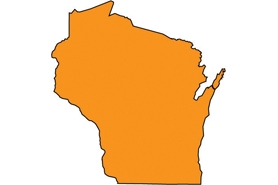Dame's rocket
(Hesperis matronalis)
Showy, short-lived perennial or biennial, 3-4' tall. Flowering stalks emerge in spring.
Other names for this plant include:
- Common names: dame's-violet, mother-of-the-evening, sweet rocket. (Sometimes mistaken for the native wood phlox.)
Classification in Wisconsin: Restricted
- Ecological Threat
-
- Invades moist and mesic woodlands on woodland edges along roadsides and open areas.
- Dame's rocket is thought by many to be a native wildflower and is found in wildflower seed mixes and planted as an ornamental.
- It quickly escapes cultivation because of its prolific seed set.
- Identification
-
First-year plants: Leaves form a basal rosette that overwinters.
Second-year leaves: Lance-shaped, finely toothed, and alternate with short to no leaf stalk (sessile or with a very short petiole). Leaves decrease in size as they ascend the stem. Fine hairs on leaves and stems—distinct light green midrib.
Flowers: Four-petaled flowers of white, pink or purple color found on large, loose, rounded inflorescences. Fragrant, especially at night. Blooms late spring through summer.
Fruits & seeds: Abundant; produced in long, narrow seed pods (siliques), up to 5" long, constricted between roots and break apart lengthwise at maturity.
Roots: Weak taproot.
Similar species: Native Phlox spp. have opposite leaves that are not toothed and flowers with five petals, not four.
Garden phlox (Phlox paniculata; non-native) has opposite leaves that are not toothed and flowers with five petals, not four—blooms in late summer.
- Control
-
Mechanical: Pull plants in early spring; plants in bloom should be bagged and disposed of in a landfill. Burn-infested areas in seedling or rosette stage.
Chemical: Foliar spray with glyphosate or triclopyr on large infestations in late fall when native plants are dormant but the basal rosettes of dame's rocket are still green.
For more information on control techniques, visit the Dame's rocket factsheet [exit DNR] by the University of Wisconsin-Extension.
- Resources
- Sources for content:
- Czarapata, Elizabeth; Invasive Plants of the Upper Midwest: an illustrated guide to their identification and control. The University of Wisconsin Press. 2005. Pg. 107-108
- Johnson, Lisa. 2001. University of Wisconsin Garden Facts, Invasive Plant Series: Dames Rocket [exit DNR].
- USDA Forest Service, Northeastern Area Forest Health Staff. Dames rocket [exit DNR].



